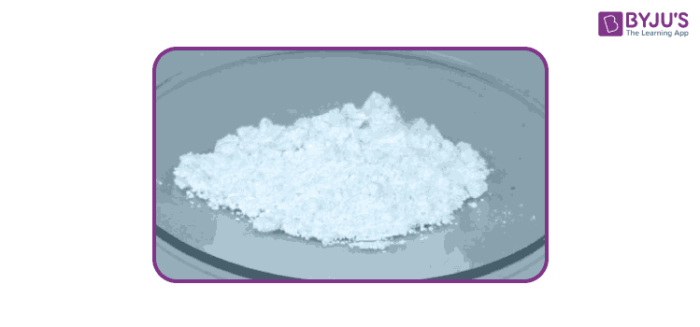What is Calcium Oxide (CaO)?
Calcium oxide, commonly known as lime, is a chemical compound with the formula CaO.
Calcium oxide, also known as quicklime, is an alkaline substance that has been in use since the medieval age. It is believed that quicklime is one of the oldest chemicals known to the human race. It can also be referred to as burnt lime or lime.

Calcium oxide has a medium viscosity and a high surface tension, plus a high to intermediate expansion and contraction rate. This material isn’t volatile at ceramic temperatures. Calcium oxide has a moderate effect on colour, except in large amounts when it may have a bleaching effect on iron oxide. It also exists in the colour of kaki/tomato reds.
Preparation of Calcium Oxide
- Calcium oxide can be produced by thermal decomposition of materials like limestone or seashells that contain calcium carbonate (CaCO3; mineral calcite) in a lime kiln.
- The process that is used to prepare burnt lime is known as calcination. It is a process that starts with thermally decomposing the reactants at high temperatures but ensuring that the temperature is kept well below the melting point.
- Calcium carbonate undergoes calcination at temperatures ranging between 1070oC-1270oC. These reactions are usually held in a rotary kiln. The products formed as a result of the reaction are burnt lime and carbon dioxide.
The carbon dioxide that is formed is immediately removed so that the reaction is preceded until the completion of the process in accordance with Le-Chatelier’s principle.
CaCO3 → CaO + CO2
This reaction is reversible and exothermic in nature in the forward direction.
Structure of CaO Molecules
Calcium oxide molecules contain one calcium cation (which holds a charge of +2) and one oxygen anion (which holds a charge of -2). The structure of calcium oxide is illustrated below.

Thus, it can be understood that calcium oxide is an ionic compound featuring an ionic bond between calcium and oxygen.
Lime Water Formula
The formula for lime water is Ca(OH)2 and the chemical name for lime water is calcium hydroxide. When water is added to lime calcium hydroxide Ca(OH)2 is formed according to the following reaction.
CaO + H2O → Ca(OH)2
This reaction is strongly exothermic and takes place vigorously with the formation of clouds of steam.
What is the Difference Between Quicklime and Lime Water?
The chemical formula of lime or quicklime is CaO. The chemical name of lime is calcium oxide. On the other hand, the chemical formula of limewater is Ca(OH)2 and the chemical name of this substance is calcium hydroxide.
Properties of Calcium Oxide
- Quick lime is an amorphous white solid with a high melting point of 2600°
- It is a very stable compound and withstands high temperatures.
- In the presence of water, it forms slaked lime. This process is called the slaking of lime.
CaO+H2O → Ca (OH)2
- It is an oxide that is basic in nature and forms salts when it comes in contact with an acid.
- This compound crystallizes in a cubic crystal lattice.
- The standard molar entropy associated with calcium oxide corresponds to 40 joules per mole kelvin.
- This compound is known to emit an intense glow when it is heated to temperatures above 2400 degrees celsius.
CaO+H2SO4 → CaSO4+H2O
| CaO | Calcium Oxide |
| Density | 3.34 g/cm³ |
| Molar Mass | 56.0774 g/mol |
| Solubility | Soluble in water & glycerol |
| Boiling Point | 2,850 °C |
| Melting Point | 2,572 °C |
Uses of Calcium Oxide
- It is extensively used for medicinal purposes and insecticides.
- It finds its application in the manufacturing of cement, paper, and high-grade steel.
- Lime is used as a reagent in laboratories for dehydration, precipitation reaction, etc.
- It is the cheapest alkali available which is an important ingredient in the manufacturing of caustic soda.
- Calcium is essential to animal life as the constituent of bones, shells, and teeth. The most common of the calcium compounds are calcium carbonate which the potter uses as a source of calcium oxide for glazes.
Important Safety Tips
- There are few things that users should keep in mind regarding Calcium Oxides.
- The reaction between quicklime and water is usually vigorous.
- Quicklime can cause severe irritation, especially when inhaled or if it comes in contact with wet skin or eyes.
- Some of the effects of inhalation include sneezing, coughing, or laboured breathing.
- Additionally, it can also result in abdominal pain, nausea burns with perforation of the nasal septum, and vomiting.
- When quicklime reacts with water it can release enough heat to even ignite combustible materials.
FAQ’s
1. Who Discovered Calcium oxide?
Ans: It was first discovered in England in 1808 when a combination of lime and mercuric oxide was electrolyzed by Sir Humphry Davy.
2. Can you drink Limewater?
Ans: Lime water mimics hydrochloric acid which is found in the stomach and, therefore, helps prevent constipation and conditions such as diarrhoea.
3. Why is calcium important for bones?
Ans: Calcium makes bones more brittle. Getting enough calcium in your diet not only maintains healthy bones but also may help prevent hypertension.
4. What are the two uses of quicklime?
Ans: It is used as a basic flux. It is used in the refining of sugar and as a disinfectant and germicide.
5. Does calcium oxide dissolve in water?
Ans: Calcium oxide dissolves in water and glycerol.
To learn more about calcium compounds, you can download BYJU’S – The Learning App.


Comments